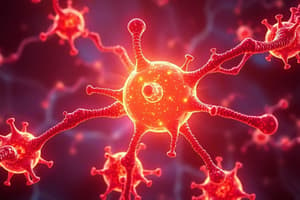Podcast
Questions and Answers
What is characterized by burning, throbbing, or aching pain states following tissue injury?
What is characterized by burning, throbbing, or aching pain states following tissue injury?
- Allodynic pain
- Nociceptive pain
- Neuropathic pain
- Hyperalgesic pain (correct)
Which of the following stimuli is considered an example of nociceptive pain?
Which of the following stimuli is considered an example of nociceptive pain?
- A light touch
- Chronic arthritis pain
- Shooting pain from a nerve
- An incision (correct)
What condition may arise from nerve injury and is associated with spontaneous dysesthesias?
What condition may arise from nerve injury and is associated with spontaneous dysesthesias?
- Hyperalgesia
- Nociceptive pain
- Peripheral neuropathy (correct)
- Rheumatoid arthritis
What process is involved in yielding various opioid peptides from precursor proteins?
What process is involved in yielding various opioid peptides from precursor proteins?
Which type of pain is thought to respond less well to opioid analgesics than acute pain?
Which type of pain is thought to respond less well to opioid analgesics than acute pain?
What transition can occur in the context of chronic tissue injury or inflammation?
What transition can occur in the context of chronic tissue injury or inflammation?
Which of the following peptides is NOT derived from the pre-POMC precursor?
Which of the following peptides is NOT derived from the pre-POMC precursor?
What type of receptors are SNC80, U69593, and Ro64-6198 classified as?
What type of receptors are SNC80, U69593, and Ro64-6198 classified as?
Which of the following opioid peptides is produced from the pre-pro dynorphin precursor?
Which of the following opioid peptides is produced from the pre-pro dynorphin precursor?
What is the role of prohormone convertases in peptide formation?
What is the role of prohormone convertases in peptide formation?
What distinguishes negative allosteric modulators from competitive antagonists like naloxone?
What distinguishes negative allosteric modulators from competitive antagonists like naloxone?
Which opioid receptor gene variant is mentioned in relation to receptor function complexity?
Which opioid receptor gene variant is mentioned in relation to receptor function complexity?
What type of research stage are positive and negative allosteric modulators currently in?
What type of research stage are positive and negative allosteric modulators currently in?
What is a common feature of the mu-opioid receptor identified in studies?
What is a common feature of the mu-opioid receptor identified in studies?
What do positive allosteric modulators do in relation to opioid agonists?
What do positive allosteric modulators do in relation to opioid agonists?
Which function is primarily associated with the phosphorylation of opioid receptors by G protein receptor kinases (GRKs)?
Which function is primarily associated with the phosphorylation of opioid receptors by G protein receptor kinases (GRKs)?
What is the significance of βγ dimers in relation to opioid receptors?
What is the significance of βγ dimers in relation to opioid receptors?
Which opioid receptor gene is mapped to chromosome 8?
Which opioid receptor gene is mapped to chromosome 8?
In which locations are opioid receptors predominantly found?
In which locations are opioid receptors predominantly found?
Which statement about the recruitment of β-arrestin is true?
Which statement about the recruitment of β-arrestin is true?
Study Notes
Introduction to Opioids and Receptors
- Pain management is a crucial clinical need, and opioid drugs remain a mainstay of treatment.
- Opioid receptors are 7-transmembrane G protein-coupled receptors (GPCRs).
- There are four types of opioid receptors: mu (μ), delta (δ), kappa (κ), and nociceptin (NOP) receptor.
- The μ-opioid receptor is primarily responsible for the pain-relieving effects of clinically useful opioid analgesics.
- Opium (from the opium poppy) contains morphine, codeine, and related compounds.
- Opiates are morphine, codeine, and structurally related compounds from opium and their semisynthetic derivatives binding to the μ-opioid receptor.
- Opioid refers to any agent that binds to the ligand-binding site of opioid receptors.
- Opioids also include fully synthetic drugs (e.g., methadone, fentanyl) and endogenous opioid peptides (enkephalins, endorphins, dynorphins).
Opioid Receptors
- The three classical opioid receptors (μ, δ, κ) share extensive sequence homology (55-58%).
- Each receptor type belongs to the rhodopsin family of GPCRs. The NOP receptor has similar structural homology.
- Opioid receptors are widely distributed in the periphery and central nervous system.
Opioid Receptor Distribution
- Mu-opioid receptors are found in brain regions involved in pain perception, mood regulation, and other behaviours.
- Kappa-opioid receptors are found in areas linked to diuresis, food intake, pain perception and neuroendocrine functions.
- Delta-opioid receptors are concentrated in olfactory, neocortical, and other brain regions, involved in pain and mood modulation.
- NOP receptors have the widest distribution, found in various brain and spinal cord areas managing pain, reward, and stress responses.
Opioid Receptor Signaling
- Agonist binding activates G-proteins, affecting downstream effectors (e.g., adenylyl cyclase, ion channels).
- G-protein subunits regulate various intracellular signals.
- Chronic opioid use leads to decreased adenylyl cyclase responsiveness and a rebound increase in cyclic AMP production.
Opioid Ligands
- Endogenous opioid peptides (enkephalins, endorphins, dynorphins) act on opioid receptors.
- The enkephalins show a preference for δ- and μ-receptors.
- Dynorphins are primary ligands for κ-receptors.
- Nociceptin/orphanin FQ is the endogenous ligand for NOP receptors, without activity at the other three opioid receptor types.
- Endomorphins are endogenous peptides highly selective for μ-opioid receptors.
Exogenous Opioid Ligands
- Agonists activate opioid receptors, altering cell signaling and producing physiological effects.
- Partial agonists bind to the orthosteric site, but produce a lower response than full agonists even with increasing doses.
- Antagonists competitively block opioid receptor binding, preventing agonist activation.
- Inverse agonists stabilize receptors in their inactive conformations.
- Biased agonists selectively activate specific intracellular signaling pathways.
- Allosteric modulators bind to a site distinct from the orthosteric site, enhancing or attenuating agonist effects.
Pharmacology of Clinically Employed Opioid Drugs
- Clinically used opioid agonists are typically selective for μ-receptors.
- Analgesia, mood changes, and impacts on respiration, cardiovascular, GI, and neuroendocrine functions are common effects.
- Side effects can also include nausea, vomiting, and drowsiness.
Pharmacology of the Prototypical Mu-Opioid Agonist Morphine
- Analgesia (reduces pain intensity or sensation) is a key effect delivered via μ-receptors.
- Euphoria (euphoric state from emotional arousal) and drowsiness as well as miosis (pupillary constriction) are frequently experienced by patients with similar conditions.
- Pain relief can occur without loss of consciousness, but can be affected by individual responses
Chronic Effects of Mu-Opioid Drugs
- Tolerance occurs to opioid agonists with repeated use, requiring larger doses to achieve the same effect.
- Physical dependence arises after chronic use. Withdrawal symptoms appear if the drug is discontinued or an antagonist is given.
- Several factors can increase the risk of respiratory depression when opioids are used.
Mechanisms of Tolerance, Dependence, Withdrawal, and Abuse Liability
- Tolerance mechanisms involve loss of opioid receptors, changes in intracellular cascades, and system-level adaptations.
- Tolerance development varies in different effectors.
- Dependence (withdrawal syndrome) is produced by drug cessation or antagonist administration.
- Withdrawal includes agitation and an elevation in physical and emotional arousal.
Opioid Overdose Treatment
- Naloxone is a rapid-acting opioid antagonist used for reversing opioid overdose symptoms, primarily respiratory depression.
Opioid-Related Antitussive Agents
- Codeine, dextromethorphan, and pholcodine suppress the cough reflex.
Additional Therapeutic Uses of Opioids
- Opioids are used to treat dyspnea (labored breathing) in pulmonary edema and other conditions.
- They are used as anesthetic adjuvants.
Overall Summary and Conclusions
- Opioids are effective for managing moderate to severe acute pain but can lead to tolerance, dependence, withdrawal, and abuse disorder.
- Opioid misuse is a serious public health concern, causing significant harm.
- The WHO analgesic ladder is an evidence-based guideline for prescribing opioids.
Studying That Suits You
Use AI to generate personalized quizzes and flashcards to suit your learning preferences.




